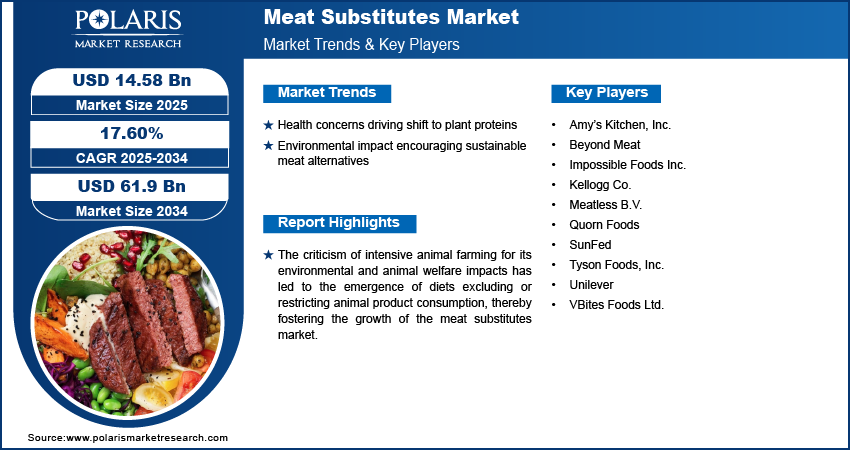The Meat Substitutes Market is poised to reach $61.9 billion by 2034, with a strong CAGR of 17.60%.

The global meat substitutes market was valued at USD 12.4 billion in 2024 and is expected to grow at a CAGR of 17.60% from 2025 to 2034. Market growth is fueled by rising health awareness and environmental concerns over meat production.
Market Trends & Insights:
- Rising Flexitarianism: A growing number of consumers are adopting a flexitarian diet—reducing meat consumption without fully eliminating it—boosting demand for meat alternatives.
- Clean Label Demand: Consumers prefer meat substitutes with simple, recognizable ingredients, pushing manufacturers to innovate with natural, minimally processed formulations.
- High-Protein Innovation: Emphasis on protein content is driving the development of new meat substitutes using legumes, grains, and emerging protein sources like fungi and seaweed.
- Global Cuisine Integration: Meat alternatives are increasingly featured in global dishes, expanding their appeal across diverse cultures and food preferences.
- Food Tech Advancements: Continuous innovation in food processing and ingredient blending is helping improve taste, texture, and mouthfeel of plant-based meats.
Market Size & Forecast
Market size value in 2025 USD – 14.58 billion
Revenue forecast in 2034 USD – 61.9 billion
CAGR – 17.60% from 2025 – 2034
Request for Free Sample:
https://www.polarismarketresearch.com/industry-analysis/meat-substitutes-market/request-for-sample
Market Overview:
The meat substitutes market is growing rapidly as consumers increasingly seek sustainable, ethical, and health-conscious alternatives to traditional meat products. Made from plant-based proteins, fungi, or cultured cells, meat substitutes aim to replicate the taste, texture, and appearance of meat while offering benefits such as lower cholesterol, reduced environmental impact, and compatibility with vegetarian or vegan diets. The market is expanding across retail, foodservice, and ready-to-eat segments, driven by lifestyle shifts and rising awareness of animal welfare and climate change.
Market Growth Drivers:
- Health and Wellness Focus: Growing awareness of the health risks associated with red meat consumption, including heart disease and obesity, is prompting a shift toward plant-based proteins.
- Environmental Sustainability: Meat substitutes require significantly fewer natural resources and generate lower greenhouse gas emissions, aligning with eco-conscious consumer values.
- Ethical and Animal Welfare Concerns: Concerns over factory farming and animal cruelty are motivating consumers to choose cruelty-free alternatives.
- Government Support & Dietary Guidelines: In some regions, policy changes and public health campaigns are encouraging reduced meat consumption, aiding the market’s expansion.
Market Challenges:
- Taste and Texture Limitations: Despite progress, some consumers find Meat Substitutes lacking the authentic flavor or texture of real meat.
- Higher Price Points: Meat alternatives are often more expensive than traditional meat, which may limit their appeal among price-sensitive buyers.
- Ingredient Sensitivities: Some products rely on soy, wheat, or other allergens, narrowing the market for consumers with dietary restrictions.
- Consumer Skepticism: Concerns about processing levels, nutritional completeness, and unfamiliar ingredients can deter adoption among health-conscious or traditional consumers.



![otoscope market Analysis: Opportunities, Innovations, and Growth Potential Through [2025-2034]](https://beeswire.com/wp-content/uploads/2025/07/polaris-76-768x768.png)


